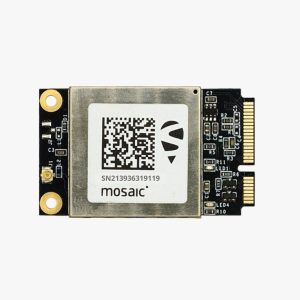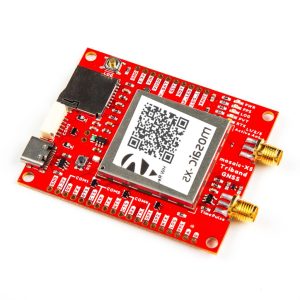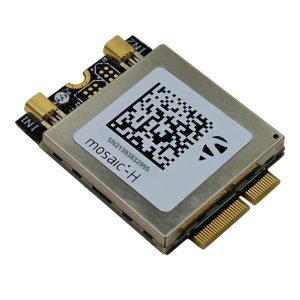Description
The Mosaic-X5 CAN GNSS provides a revolutionary solution for high-precision navigation, powered by Septentrio’s advanced L1/L2/E5 RTK GNSS receiver. With a groundbreaking 100Hz update rate, it is designed for robust, high-speed, and low-latency applications, making it a game-changer for UAVs, robotics, and industrial automation.
It is packed with CAN connectivity, an RM3100 magnetometer, a DPS310 barometer, and a Wi-Fi module, offering seamless remote access to its web server for real-time monitoring and configuration. Its lightweight yet durable plastic enclosure combines the antenna, receiver, and CAN node into a single, compact unit. This innovative design eliminates signal degradation caused by long cables and connectors, ensuring optimal performance.
Built on Septentrio’s AIM+ technology for interference mitigation, LOCK+ for stable signal tracking under vibrations, and RAIM+ for enhanced integrity, the Mosaic CAN GNSS guarantees reliable performance even in demanding environments. Whether you’re optimizing UAV navigation, conducting spectrum analysis, or ensuring precise asset tracking, this receiver is the perfect choice for a broad range of mission-critical applications.
Specifications:
- Model: mosaic-X5
- Constellations Supported: GPS (L1/L2/L5), Galileo (E5b), Glonass (L1/L2)
- Compatibility: Ardupilot (NMEA), PX4
- Compass: RM3100
- Barometer: DPS310
- RTK Ready: Yes
- USB Port: Yes (Type C)
- CAN Ready: Yes
- SD Logging: Yes
- Operating Temperature Range: -40°C to 85°C
- LED Indicators:
- ARM: RGB LED
- Status: PPS, LOG, PWR, MCU, USR
- Dimensions: 2¾ in x 2 in (70mm x 51mm)
- Weight: 2 oz (57 g)
- Mounting Holes: 5 x M2 for self-tapping screws on the bottom side
MOSAIC-X5 module features:
- 31.0 x 31.0 x 4.2 mm LGA package
- Supports all-constellatiion multi-frequency on-chip RTK positioning and dual-antenna heading solution
- Supports GPS L1/L2, BDS B1I/B2I/B3I, GLONASS G1/G2, Galileo E1/E5b and QZSS L1/L2
- All-system multi-frequency RTK engine and advanced RTK technology
- AIM+: Industry leading Anti-jamming, Anti-sppofing Interference Monitoring and Mitigation
- IONO+: Advanced protection against ionospheric disturbances to GNSS signals
- APME+: a posteriori multipath estimator for code and phase multipath mitigation
- LOCK+: superior tracking robustness under heavy mechanical shocks or vibration
- RAIM+: Advanced Receiver Autonomous Integrity Monitoring
Performance Specifications:
Frequency
- GPS L1C/A, L1PY, L2C, L2P, L5
- BDS B1I, B1C, B2a, B2b, B2I, B3
- GLONASS L1CA, L2CA, L2P, L3 CDMA
- Galileo E1, E5a, E5b, E5 AltBoc, E6
- QZSS L1C/A, L1C/B, L2C, L5
- Navic L5
- SBAS: Egnos, WAAS, GAGAN, MSAS, SDCM (L1,L5)
- On-module L-band
Single point positioning (RMS):
- Horizontal: 1.2 m
- Vertical: 1.9 m
- Time Precision(xPPS out) – 5 ns
- Data Update Rate: 100 Hz
DGPS (RMS):
- Horizontal: 0.4 m
- Vertical: 0.7 m
- Cold start < 45 s
- Initialization Time < 7 s (typical)
- Data Update Rate: 100 Hz
RTK (RMS):
- Horizontal: 0.6 cm + 0.5 ppm
- Vertical: 1cm + 1 ppm
- Data Update Rate: 100 Hz
- Differential Data – RTCM V2.x, V3.X (MSM included), CMR v2.0/CMR+ (input only)
- Data Format – NMEA-0183, v2.3, v3.03, v4.0, RINEX v2.x, v3.x, Septentrio Binary Format (SBF)
Physical Characteristics:
- Packaging: 239 pin LGA
- Dimension: 31.0 × 31.0 × 4.2 mm
- Weight: 6.8g
Environmental Specifications:
- Working temperature: -40 °C ~ +85 °C
- Storage temperature: -55 °C ~ +85°C
- Humidity: 95% No condensation
- Vibration: MIL-STD-810G
Communication Interfaces:
- 4 × UART (3 with hardware flow control)
- 1 × USB (2.0, HS)
- 1 × Ethernet (RMII/MDIO), 10/100 Mbps
- 1 x SD memory card
- 2 x Event inputs
- 2 x GPIO
- 1 x PPS out
Features of Mosaic CAN GNSS:
High-Performance GNSS Receiver: Powered by Septentrio’s L1/L2/E5 GNSS receiver for precise and reliable positioning.
Integrated CAN Bus Connectivity & 100Hz Update Rate: Enables seamless communication and integration with UAVs, robotics, and other industrial systems. It ensures real-time, high-speed, and low-latency positioning data for dynamic applications.
Advanced Interference Mitigation (AIM+): Protects against intentional and unintentional jamming, ensuring consistent performance in challenging RF environments.
Vibration and Shock Resistance (LOCK+): Maintains reliable signal tracking during high-vibration or shock conditions, ideal for UAVs and robotics.
Comprehensive Data Tools: Features spectrum analysis, data logging, and post-processing capabilities for enhanced flexibility and diagnostics.
RAIM+ Algorithm: Delivers unparalleled integrity and reliability, suitable for mission-critical applications.
Integrated Sensors and Modules: Includes an RM3100 magnetometer and a DPS310 barometer for enhanced environmental data accuracy.
Wi-Fi Module with Web Server Access: Provides remote configuration and monitoring through Mosaic-X5’s integrated web server.
Applications of Mosaic-X5 CAN GPS
UAVs (Unmanned Aerial Vehicles): Our high-precision navigation and positioning solutions for drones enable real-time flight path monitoring and autonomous operations. These cutting-edge solutions are made to satisfy the needs of applications that demand fast, low-latency updates. They work especially well for jobs where precision and quickness are essential, like mapping, aerial surveying, and agricultural monitoring.
Robotics: For autonomous robots working in industrial settings, our GNSS integration offers precise and dependable navigation. It is perfect for a variety of robotic applications since it guarantees accurate movement and operation even under extreme vibration conditions. Our technology facilitates smooth navigation and operation, allowing robots to carry out duties in demanding environments with high efficiency and dependability, whether in warehouses, agriculture, or outdoor exploration.
Industrial Monitoring: This system is excellent at sustaining dependable performance even in trying circumstances, making it useful for asset tracking in distant or rugged environments. Its sophisticated networking capabilities allow for easy equipment performance monitoring and administration, offering real-time insights to maximize operations. It is widely used in sectors including mining, oil, and gas and is an essential tool for demanding applications since it ensures operational efficiency and minimizes downtime.
Marine Applications: For autonomous underwater and surface vehicles (AUVs/ASVs), our GNSS solutions offer dependable navigation, guaranteeing smooth operation even in difficult marine conditions. Our systems, which are built to provide accuracy and stability, operate exceptionally well under changing circumstances, allowing for precise positioning and improved performance for a variety of maritime applications.
Security and Surveillance: Our products make it possible to follow valuable assets in real time while they are in transit, guaranteeing constant security and visibility. They also provide location-based monitoring for sensitive locations and key infrastructure, offering precise and trustworthy data to protect vital assets and operations.
How does Mosaic CAN GNSS differ from traditional GNSS receivers?
In contrast to conventional GNSS receivers, the Mosaic CAN GNSS module combines the advantages of CAN bus communication’s adaptability with high-precision satellite positioning. This integration is perfect for applications that need accurate and dependable positioning data since it facilitates effective real-time data interchange, simplifies wiring, and improves synchronization across various devices.
How can I integrate Mosaic CAN GNSS into my existing system?
The Mosaic CAN GNSS’s compatibility with common CAN bus protocols makes it simple to integrate into your current system. The module can be linked to the CAN network of your system, allowing for smooth data exchange and communication with other CAN-capable devices. To help with setup and integration, thorough documentation and support materials are offered, guaranteeing a seamless implementation and operation.
What benefits does CAN integration provide for GNSS systems?
CAN integration offers several advantages for GNSS systems, including:
- Efficient Data Communication: Real-time data sharing with reduced latency across multiple devices.
- Simplified Wiring: Reduced cabling requirements, lowering complexity and minimizing failure points.
- Enhanced Control and Coordination: Easier synchronization and management of devices within the network.
Scalability: Effortless addition of new devices to the CAN network without major system changes.







